 It’s time for a Fleischer Color Classic in this week’s breakdown!
It’s time for a Fleischer Color Classic in this week’s breakdown!
Of all the notable classical music compositions, Franz Liszt’s second Hungarian Rhapsody is a staple of animated cartoons. In this film, a lion conductor (performed by radio announcer David Ross) addresses the audience and allows them to reconsider the animal orchestra in a dignified manner, instead of expecting their usual slapstick antics. The Fleischer studio previously used this music during the finale of Fire Bugs, a 1930 Talkartoon with Bimbo. Among its most famous usages are in two cartoons directed by Friz Freleng — Rhapsody in Rivets (1941) and Rhapsody Rabbit (1946), the latter of which has similarities to The Cat Concerto (1947) with Tom and Jerry. UPA’s The Magic Fluke (1949), with The Fox and the Crow, and Walter Lantz’s Convict Concerto (1954), with Woody Woodpecker also exploited the composition for comedic effect.
Dave Tendlar is the head animator, and “de-facto” director on A Car-Tune Portrait; he animates a few brief long shots of the lion conductor in the film. As indicated on the draft, Tendlar also contributed to the story with Dave Fleischer and Izzy Sparber. Nick Tafuri, who animates the lion’s opening speech to the audience, is given screen credit under Tendlar. The draft indicates the other animators on “Animal Orchestra” (the working title) were Herman Cohen, Bill Sturm, Eli Brucker, Joe Oriolo and Jack Rabin, credited as “Rubin”.
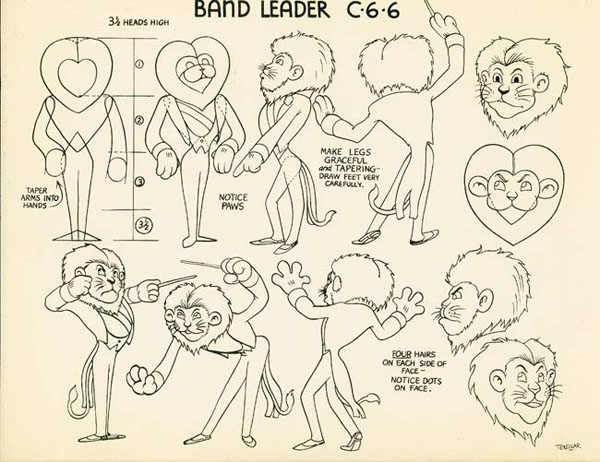
Joe Oriolo animates the sequence, in scenes 11-14, where the lion conductor notices a sleeping orchestra member and roars to awaken him. Oriolo worked as a showcard writer for Sears Roebuck before he became an errand boy at Fleischer’s in April, 1933, at age 20. He moved with the studio when they relocated to Miami in 1938, for the preparation of their first feature Gulliver’s Travels, and remained when the studio was re-established as Famous Studios in the early ‘40s. During his time there, he and children’s author Seymour Reit sold the rights to their character Casper the Friendly Ghost, originally intended for children’s books, to Famous, where it became the studio’s most popular character.
Oriolo left Famous Studios in 1944 to open his own television production studio, freelancing on industrial projects and films for the Armed Forces. Otto Messmer, whom he met at Famous during his brief tenure as a story artist, recruited him as his assistant on comic book stories of Felix the Cat in the mid-‘40s, as published by Dell and Toby Press. Gradually, the Felix stories seemed to be split between Messmer and Oriolo. Around 1954, King Features Syndicate dropped Messmer and wanted Oriolo to continue the drawing duties on the comics. He gradually took legal ownership of Felix and revived him in a television series of 260 episodes, distributed by Trans-Lux.
Jack Rabin is credited for one shot in A Car-Tune Portrait — it could be speculated he was an assistant animator and was given a chance to draw a scene in this film. He moved with the studio to Florida, and roomed with animator — and later Famous story artist—Irv Spector during his stay. He left Fleischer’s, and animation altogether, in 1941 when low-budget studio Monogram Pictures hired him. Rabin went into Warner Bros.’ montage department, working with director Don Siegel. Later, he became head of the effects department at Eagle-Lion, on such films as The Black Book (1949), The Noose Hangs High (1948) and Raw Deal (1948). Rabin formed his own company, Imagic Co., which would later be changed to Jack Rabin & Associates. He specialized in photographic effects and matte paintings on productions such as The Night of the Hunter (1955), Around the World in Eighty Days (1956) and Death Race 2000 (1975).
There’s some confusion with Rabin’s surname during his time at Fleischer’s; surviving gag drawings from the in-house Fleischer’s Animated News credit him as “Jack Rubin.” However, his film credits list him as “Jack Rabin.” It’s unclear as to the change in nomenclature—it could be that Rubin was chosen as an anglicized version of Rabin.
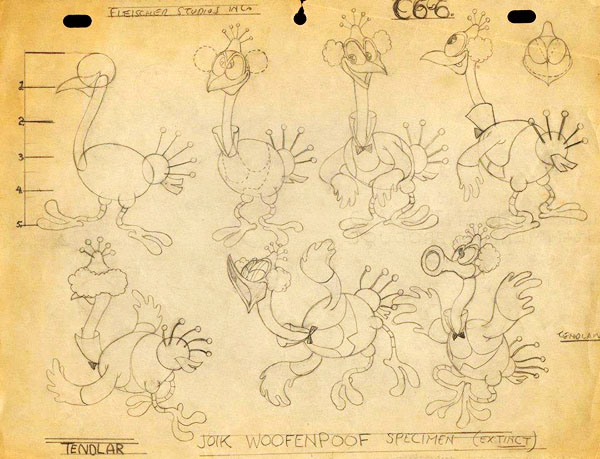
The draft here is dated January 20, 1937; the film was released June 26. In between these dates, animator Herman Cohen left for the West Coast to work at Warners in Ben Hardaway and Cal Dalton’s unit by April 1937. More importantly, on May 7 of that year, about 100 of the staff went out on strike. Brucker was the only animator who refused to cross the picket line. Found in Dave Tendlar’s personal files, Jerry Beck previously posted this document here in 2013; no other Fleischer drafts up to this point are accessible at the moment, and we can only hope more surface.
The draft doesn’t list the opening sequences of a known Fleischer trademark—the artist’s hand painting the principal characters and the proscenium in the film. This cartoon would have been too short in duration without these sequences, hence their inclusion. In the film, scene 22 seems to be a repeat of scene 20, credited to Tendlar, but the draft credits the latter shot to Nick Tafuri.
Enjoy the breakdown video! This next one might be my most extensive yet…
As an added treat, the only other available Tendlar-directed Fleischer Color Classic, The Great Vegetable Mystery, which I posted about last April, has finally been presented in a decent color print. You can see the updated version here:
(Thanks to Jerry Beck, Bob Jaques, Nick Richie and Yowp for their help.)



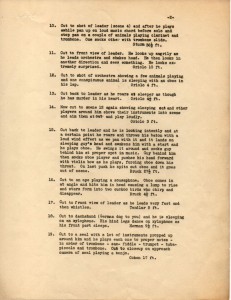
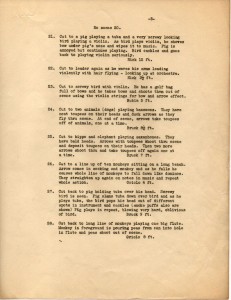

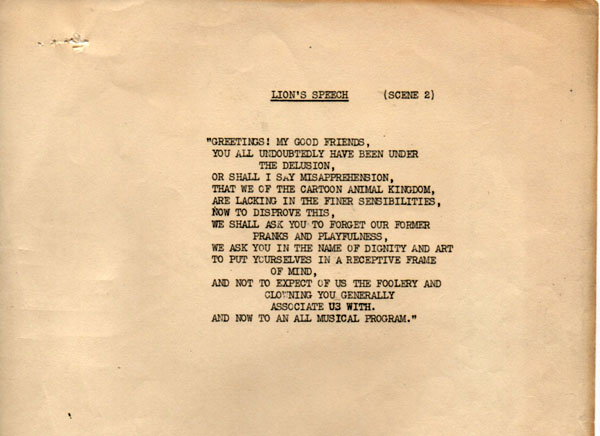
 DEVON BAXTER is a film restoration artist, video editor, and animation researcher/writer currently residing in Pennsylvania. He also hosts a
DEVON BAXTER is a film restoration artist, video editor, and animation researcher/writer currently residing in Pennsylvania. He also hosts a 





















































































This is an odd print of Fresh Vegetable Mystery. Cuts out the whole Color Classic title card (but it’s nice to hear the Paramount opening theme for the first time).
The “Paramount presents A Max Fleischer Color Classic in Technicolor” title wasn’t cut out, it was heavily censored over with those infamous black bars.
NTA prints were always inconsistent in how they place those black bars.
I know U.M.& M. cut their titles straight onto the original camera negatives of the B&W shorts, but does anybody know if NTA made their alterations on duplicates or the original elements of the color cartoons?
They made them on duplicate elements.
I had no idea Herman Cohen worked at Fleischer Studios!!
Seen this before, but pretty cool breakdown!
The Fleischer Studio would use Liszt’s Hungarian Rhapsody No. 2 once more – throughout their 1942 two-reeler The Raven, which lampoons Poe’s eponymous book.
Somehow, I’d forgotten that. Thanks for reminding me!
Also there was a segment from the “Son of Acme Looniversity Daze (Days)” from Tiny Toon Adventures episode entitled C Flat or B Sharp which used Franz Liszt Hungarian Rhapsody No.2 as the segment’s background music in where Yosemite Sam has Buster Bunny,Plucky Duck and Hamton J. Pig retrieve a concert grand piano (which was somehow place on top of the Looniversity’s bell tower and bring it down to the concert hall.
Also there were two scenes in the segment one which the way Buster was standing look a little like Crusader Rabbit, & in the second see where Fifi LeFume was prancing down the Looniversity’s hall way leaving a “scent” behind in which Montana Max , Dizzy Devil and a couple of other toons were K.O.ed &. You could hear them snoring but in later broadcasts you could see Fifi prancing and the snoring from the toons but minus the toons.
And the tile card paid homage to Chuck Jones classic animated masterpiece High Note featuring the drunken note who caused chaos throughout the cartoon.
Hum! Benny Goodman reference at the 3:20 mark in Car-Tune, if I’m not mistaken… 🙂
That is probably the best print I’ve ever seen of this particular cartoon, though I’m sure after restoration it would look a lot better. It’s nice not to hear the dialogue clipped as I’ve heard on so many prints.
Terrific cartoon; such talented artists. But who thought up the gags?